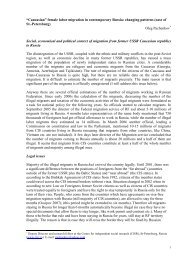THORIUM AS AN ENERGY SOURCE - Opportunities for Norway ...
THORIUM AS AN ENERGY SOURCE - Opportunities for Norway ...
THORIUM AS AN ENERGY SOURCE - Opportunities for Norway ...
You also want an ePaper? Increase the reach of your titles
YUMPU automatically turns print PDFs into web optimized ePapers that Google loves.
Thorium as an Energy Source - <strong>Opportunities</strong> <strong>for</strong> <strong>Norway</strong><br />
The heavy metal was used in <strong>for</strong>m of coated BISO particles (particles with two layers of pyrolytic<br />
carbon).<br />
Figure 5.6: Balance of Fissile Material during the Passage through the Reactor in the Thorium/Denatured<br />
Uranium Cycle (MEU Cycle).<br />
(Source: “Use of Thorium in the nuclear technology – experiences in Germany” [48])<br />
It is of great importance in this context that the isotope Pa-233 not only may decay to the fissile<br />
material U-233, but may also be converted to Pa-234 by a (n, γ)-reaction with a high reaction cross<br />
section (110 barn). This leads to a significant loss with regard to the breeding of new fissile<br />
material. The neutron flux level and the fuel element design are additional parameters of great<br />
importance with regard to the utilisation of thorium in a HTR. The neutron flux should be as<br />
small as possible to realise high breeding gains.<br />
During the open uranium cycle of the HTR, about 90 % of the plutonium bred during operation of<br />
the reactor is burned directly in–situ in the reactor. There<strong>for</strong>e the plutonium content of the spent<br />
fuel elements is very low and additionally is denatured by higher isotopes.<br />
Closed cycles, which can be operated with enriched uranium (20wt%) and thorium and which<br />
show a very good proliferation resistance, may show high conversion rates and there<strong>for</strong>e a<br />
reduced uranium demand. For the realisation of closed fuel cycles <strong>for</strong> HTRs as well as <strong>for</strong> other<br />
reactor concepts, economic reprocessing capacities have to be available [54], [55], [56], [57], [58]<br />
and [59].<br />
5.3.2.3 HTR as Converter and Breeder Systems<br />
Thorium allows in principle the realisation of breeding in helium cooled High Temperature<br />
Reactors (HTRs), in heavy water (D2O) cooled systems and in Molten Salt Reactors (MSRs). These<br />
three options have been studied extensively in Germany in the past but only the HTR fuelled<br />
with thorium and U-233 is commented here. For high conversion or breeding in a HTR, the<br />
thorium cycle is favoured. However, a HTR Th-U breeder requires a low moderation ratio and a<br />
low fuel burnup. In the report summarizing the German experiences [48] a symbiotic HTR system<br />
consisting of two pebble bed HTRs are discussed, where one acts as a “pre-breeder”, producing U-<br />
233 <strong>for</strong> the second HTR. Both reactors need reprocessing, and a breeding ratio of 1.026 (produces<br />
2.6 % more fissile material than it consumes) was estimated. However, this design was never<br />
realized as a prototype.<br />
46

















